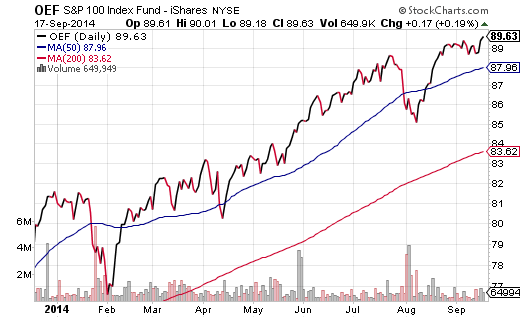The market supposedly climbs a “Wall of Worry,” at least until those concerns overwhelm participants. Yet the only apprehension that might have sent stock investors for the exit doors yesterday related to the timing and the pace of central bank rate hikes. When it comes to a number of the traditional alarms – geopolitical struggles, global economy, profit margin contraction, fundamental valuation, domestic political change – nobody seems to care.
Imagine a world before the Federal Reserve’s quantitative easing (QE) and zero percent rate policy. Can you still remember it? Now picture how U.S. stocks might have reacted to escalating military conflicts between the U.S. and ISIS in the Middle East, as well as clashes between Russia and Ukraine in Eastern Europe. There are always wars, you say? Then envision the bloodshed occurring alongside slowing growth around the globe. Normally, you’d expect a fair amount of angst about a global economic slowdown coupled with geopolitical tension. In today’s ultra-low rate world, however, the Dow’s response remains bullish.
Perhaps the market trusts the resilience of the U.S. economy, in spite of soldierly combat abroad and waning GDP (i.e., gross domestic product) in specific countries. It is possible. On the other hand, when profit margins set records, they tend to peak and subsequently subside. Corporations have already slashed expenditures to the bone and the rapid ascendance of the U.S. dollar hurts the foreign currency-generated profits of U.S. multinationals. These realities would typically stoke profit margin fears; the almighty Dow would likely struggle. In today’s world of electronic money creation and ultra-easy bank borrowing, however, the Dow looks poised to set new records.
It becomes even more difficult to conceptualize a cheerful U.S. stock market when one adds yet another jittery brick to the wall. Whether one is looking at price-to-earnings, price-to-cash flow, price-to-sales, price-to-dividends or price-to-book, stocks are decidedly overvalued. Once again, if central bank interference were not in the driver’s seat, would investors overlook geopolitical collisions, global economic dangers, profit margin contraction and severe overvaluation? Now factor in a high probability that the legislative branch of the United States shifts from one party to another. Certainly, U.S. markets would pull back under the weight of so many doubts.
Instead, Federal Reserve manipulation (12/08-present) has won the hearts and the wallets of the investing public. Nothing else matters. Even as I type this commentary, chairwoman Janet Yellen has assured shareholders that the U.S central bank will maintain its ultra-accommodating stance for a “considerable time.” In other words, one should not expect overnight lending rates to move up a great deal in 2015 (if at all). Yellen even discussed using “rate ranges” as opposed to specific percentages when the Fed attempts to push the envelope.
From my perspective, the Fed’s “go-it-super-slow” approach is bullish for longer duration bonds that one can acquire via Vanguard Long Term Bond (ARCA:BLV). I might also look to scoop up intermediate-term municipal bonds via SPDR Nuveen Muni (NYSE:TFI) or longer-term munis via Market Vectors Long Municipal Index Fund (NYSE:MLN).
Without question, the largest players in the financial markets have unwavering confidence in monetary powers. Some of those large players include the companies themselves, entities that have offered low yielding debt to the risk-averse and used the proceeds to “acquire-n-retire” corporate shares. Probability alone might suggest that three calendar years without a 10% correction speaks volumes about irrational optimism. Nevertheless, investors with higher-than-desired cash levels cannot ignore Fed-infused capital appreciation potential.
The ultimate question, then, is which stock ETFs may offer the best risk-reward possibilities. The Bespoke Investment Group simplified the answer by tracking the divergences in advance-decline lines. In brief, fewer small- and mid-sized corporations have participated in the 2014 rally; exposure to small-cap stock ETFs and mid-caps stock ETFs tracking the S&P 600 and S&P 400 respectively should be lessened. In contrast, one might dollar-cost average into larger-cap stock ETFs where the bull market still charges forward. I like iShares USA Minimum Volatility (NYSE:USMV) and iShares S&P 100 (NYSE:OEF).
Disclosure: Gary Gordon, MS, CFP is the president of Pacific Park Financial, Inc., a Registered Investment Adviser with the SEC. Gary Gordon, Pacific Park Financial, Inc., and/or its clients may hold positions in the ETFs, mutual funds, and/or any investment asset mentioned above. The commentary does not constitute individualized investment advice. The opinions offered herein are not personalized recommendations to buy, sell or hold securities. At times, issuers of exchange-traded products compensate Pacific Park Financial, Inc. or its subsidiaries for advertising at the ETF Expert web site. ETF Expert content is created independently of any advertising relationship.


